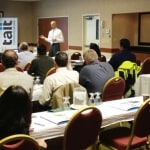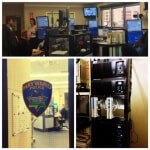 The Education Nation team has traveled thousands of miles this year and we’ve met hundreds of people from public safety and utility organizations across the country. Our mission was simple — to provide free education to officials faced with the task of procuring, upgrading or maintaining radio communications systems. It’s a tough job to summarize the deep discussions, highlights and learnings from the tour, but here goes…
The Education Nation team has traveled thousands of miles this year and we’ve met hundreds of people from public safety and utility organizations across the country. Our mission was simple — to provide free education to officials faced with the task of procuring, upgrading or maintaining radio communications systems. It’s a tough job to summarize the deep discussions, highlights and learnings from the tour, but here goes…
Texas
The seminar series kicked off in Texas, home to Tait Communications’ Americas headquarters. Bill Fillman, Vice-President of Principal Consultants, did an outstanding job leading the Texas sessions. His P25 Phase 2 myth-busters generated some great conversation about Phase 2, Phase 1 compatibility, as well as analog and agency interoperability. The Texas groups agreed that the P25 Phase 2 standards, when developed, must be able to divert back to analog conventional to support national mutual-aid channels. Another handy tip from the Houston group was that it’s extremely important to test your Phase 2 system for interoperability with other Phase 1 systems in your area — again, bearing in mind that the standards haven’t yet been developed for Phase 2.
- The team hits the road!
- Visit to the Nacogdoches Fire Department
- NASA’s Johnson Space Center
- San Antonio Emergency Medical Services
En route to the seminar locations — Nacogdoches, Houston and San Antonio — we stopped at several special local landmarks, including the Sam Houston Memorial and the NASA Space Center, in Alamo. A big thank-you to the Nacogdoches Fire Department for taking us through the Central Fire Station Historic Museum — very impressive.
Ohio, Indiana and FDIC
Proprietary versus open standards was the main talking point of the Ohio and Indiana classes. Education Nation Leader, and Director of Network Compliance Engineering, Nick Pennance covered everything from proprietary communications systems to proprietary radio features that can transform your standards-compliant radio to a proprietary device. When asked which direction was the best one to take, Nick responded: “We’re not here to make the choice for you; we’re here to illustrate the advantages and disadvantages of both, so you can make a decision on which best meets your critical communications requirements and financial outlook.”
- Nick leads Kokomo seminar
- Indiana State Police Museum
- FDIC 2013, Indianapolis
- Ohio Fire Museum
The week finished at the world’s largest firefighter training conference, the Fire Department Instructors Conference (FDIC). The team proudly demonstrated the Tait BioLink biometric information system that operates over P25 radio links. Designed for first-responders, the solution was very well received by firefighters at FDIC.
California
Not a spare seat in sight in the California sessions, which were held in Riverside, Bakersfield and Sacramento. Bill Fillman’s 10 Steps to Migration Success were a hit, and coverage was a very hot topic with many of the Californian agencies we spoke with. One agency commented: “Nothing is more important than coverage; we have hilly terrain in just about all of our counties.” Bill advised the classes to identify coverage priorities and to specify more than a minimum coverage percentage to achieve a successful system migration.
In Bakersfield, the Education Nation team learned a brand-new term, “Tule Fog” — thick ground-fog that causes radio interference for agencies in Central Valley.
- Riverside seminar led by Tait’s Bill Fillman
- Bakersfield, California
- California State Capitol
- Customer Visit: Hayward Police Department
To sum up, while each state had varying communications concerns, all agreed that, in an emergency, mission-critical voice is a must-have; all other forms of communication were simply nice-to-haves.
Encore!
We’re pleased to announce that, due to popular demand, the Education Nation series will be continuing throughout the year across the United States. More dates have been added to the free seminar series — register online to find a location near you.
“Attended the session in Sacramento. Well worth the time to attend. The three-hour LMR presentation is not a sales pitch for Tait” — Shel Leader, ITS Communications, San Francisco Bay Area















